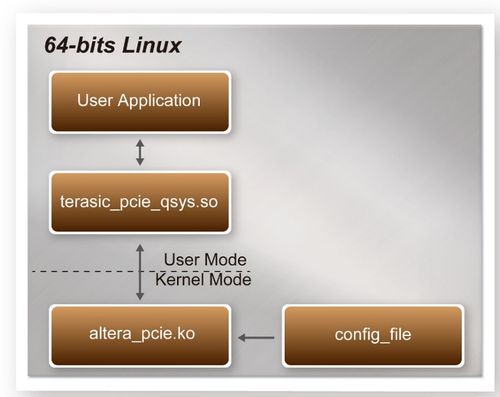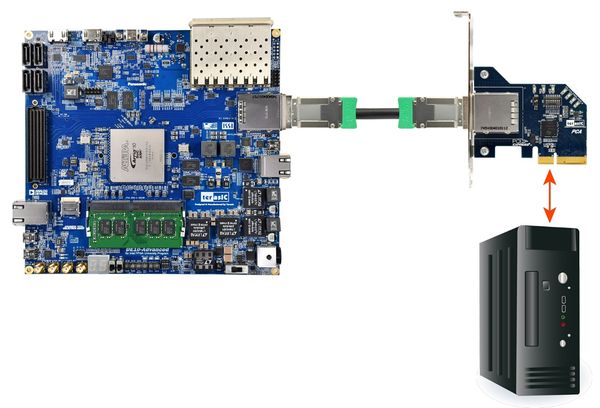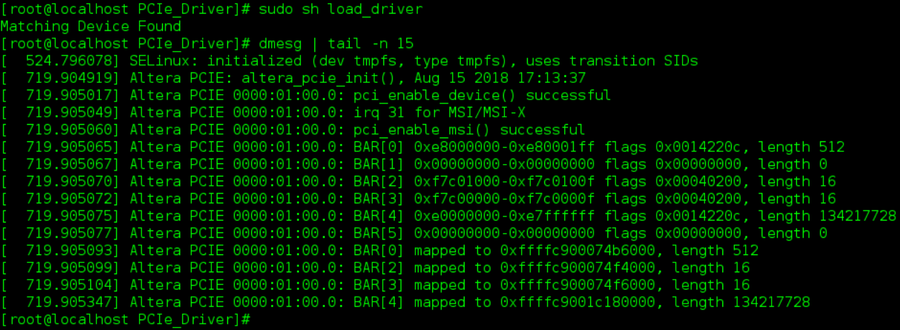DE10-Advanced revC demo: PCI Express Software Stack Linux
From Terasic Wiki
Figure 1-1 shows the software stack for the PCI Express application software on 64-bit Linux. The PCIe library module terasic_pcie_qys.so provides DMA and direct I/O access for user application program to communicate with FPGA. Users can develop their applications based on this .so library file. The altera_pcie.ko kernel driver is provided by Altera.
- Figure 1-1 PCI Express Software Stack
Install PCI Express Driver on Linux
To make sure the PCIe driver can meet your kernel of Linux distribution, the driver altera_pcie.ko should be recompile before use it. The PCIe driver project is locate in the folder:CDROM/Demonstrations/PCIe_SW_KIT/Linux/PCIe_Driver
The folder includes the following files:
- altera_pcie.c
- altera_pcie.h
- altera_pcie_cmd.h
- Makefile
- load_driver
- unload
- config_file
To compile and install the PCI Express driver, please execute the steps below:
- Make sure the DE10-Advanced and the PC are both powered off.
- Plug the PCIe adapter card into the PCIe slot on the PC motherboard. Use the PCIe cable to connect to the DE10-Advanced PCIE connector and the PCIe adapter card (See Figure 1-2)
- Power on your DE10-Advanced board and the host PC
- Open a terminal and use "cd" command to goto the folder"CDROM/Demonstrations/PCIe_Fundamental/demo_batch".
- Set QUARTUS_ROOTDIR variable pointing to the Quartus installation path. Set QUARTUS_ROOTDIR variable by tying the following commands in terminal. Replace “/home/centos/intelFPGA/18.0/quartus” to your quartus installation path.
- export QUARTUS_ROOTDIR=/home/centos/intelFPGA/18.0/quartus
- Execute "sudo -E sh test.sh" command to configure the FPGA
- Restart Linux operation system. In Linux, open a terminal and use “cd” command to goto the PCIe_Driver folder
- Type the following commands to compile and install the driver altera_pcie.ko, and make sure driver is loaded successfully and FPGA is detected by the driver as shown in Figure 1-3.
- *make
- *sudo sh load_driver
- *dmesg | tail -n 15
Create a Software Application
All the files needed to create a PCIe software application are located in the directory CDROM/Demonstrations/PCIe_SW_KIT/Linux/PCIe_Library. It includes the following files:
- TERASIC_PCIE_AVMM.h
- terasic_pcie_qsys.so (64-bit library)
Below lists the procedures to use the library in users’ C/C++ project:
- Create a 64-bit C/C++ project.
- Include TERASIC_PCIE_AVMM.h in the C/C++ project.
- Copy terasic_pcie_qsys.so to the folder where the project execution file is located.
- Dynamically load terasic_pcie_qsys.so in C/C++ program. To load the terasic_pcie_qsys.so, please refer to the PCIe fundamental example below.
- Call the library API to implement the desired application.
Users can easily communicate with the FPGA through the PCIe bus through the terasic_pcie_qsys.so API. The details of API are described below:


